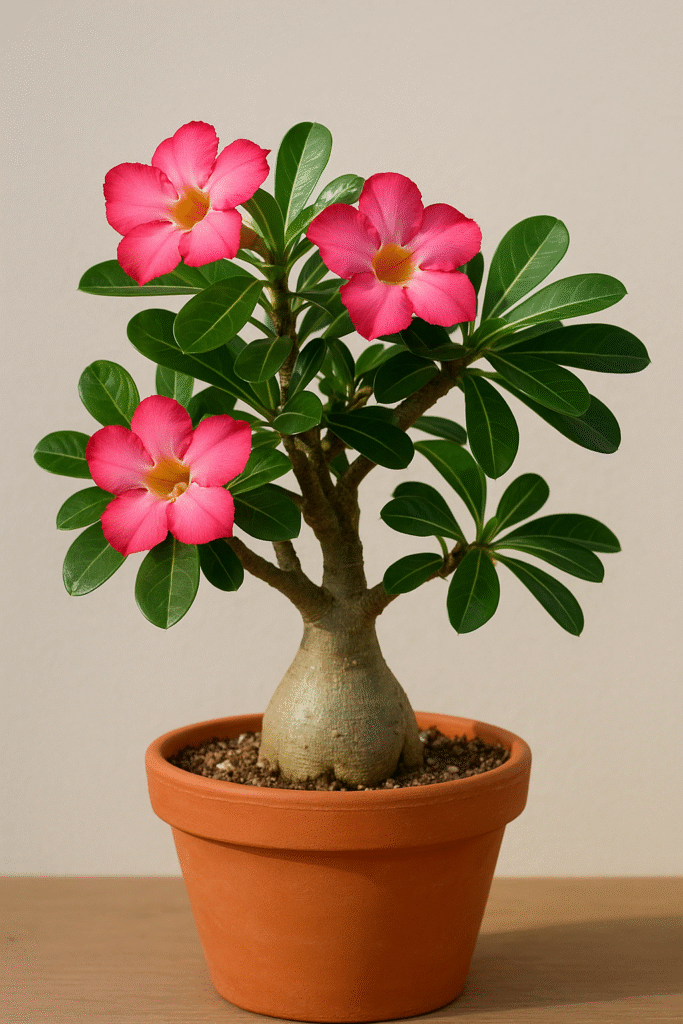The Desert Rose plant (Adenium obesum) is a stunning tropical succulent admired for its thick, sculptural trunk and vibrant, trumpet-shaped flowers. Native to Africa and the Arabian Peninsula, this plant perfectly balances toughness and beauty — thriving in hot, dry conditions while producing some of the most eye-catching blooms in the plant world. Whether you’re growing it indoors or outdoors, the Desert Rose is sure to bring a touch of exotic elegance to your garden or home décor.
Introduction to the Desert Rose Plant
The Desert Rose belongs to the Apocynaceae family, which includes oleanders and periwinkles. It’s known for its unique swollen stem base, known as a caudex, which stores water and gives the plant its bonsai-like appearance. This feature makes the Desert Rose not only beautiful but also incredibly drought-tolerant.
Its vibrant flowers — ranging from pink, red, and white to deep purple — make it a favorite among gardeners who want a low-maintenance plant with striking aesthetics.

Ideal Growing Conditions
To grow a healthy and blooming Desert Rose, you need to provide the right conditions.
Light Requirements
The Desert Rose loves full sun. It requires at least 6 hours of bright, direct light daily to maintain its shape and bloom regularly. If grown indoors, place it near a sunny window or under a grow light.
Temperature and Humidity
As its name suggests, the Desert Rose thrives in warm, dry climates. The ideal temperature range is between 21°C and 32°C (70°F–90°F). Protect it from frost, as cold weather can damage the roots and leaves. During winter, keep it indoors if the temperature drops below 10°C (50°F).
Soil Requirements
Use well-draining sandy or cactus mix soil. Poor drainage can lead to root rot — the most common issue with Adeniums. You can mix perlite, coarse sand, and garden soil to create a perfect potting medium.
Watering and Feeding
Although the Desert Rose is drought-tolerant, it still needs proper watering to stay healthy.
- Watering: Allow the soil to dry out completely between waterings. Overwatering can cause the caudex to rot. During its active growing season (spring and summer), water thoroughly but ensure no standing water remains in the pot. In winter, reduce watering drastically.
- Fertilizing: Use a balanced liquid fertilizer (10-10-10) every 4–6 weeks during the growing season. Avoid fertilizing during dormancy. Proper feeding enhances flower production and overall health.
Pruning and Maintenance
Pruning helps maintain the plant’s shape and encourages more blooms.
- Remove any dead or yellow leaves regularly.
- Cut back leggy branches to promote bushier growth.
- Always use sterilized pruning tools to prevent infection.
You can also shape your Desert Rose into a bonsai-style plant by pruning strategically and exposing the caudex above the soil.

Propagation Methods
The Desert Rose can be propagated through seeds or cuttings.
- From Seeds: Sow seeds in warm, moist soil and keep them in a bright location. Germination usually takes 7–10 days.
- From Cuttings: Take a healthy stem cutting, allow it to dry for a day, then plant it in well-draining soil. Keep it slightly moist until roots develop.
Propagation from cuttings grows faster but may not form a large caudex like seed-grown plants.
Common Problems and Solutions
Although hardy, the Desert Rose can face some issues if care is neglected:
- Yellow Leaves: Usually caused by overwatering or poor drainage. Let the soil dry out fully.
- No Blooms: Insufficient sunlight or lack of nutrients. Move the plant to a sunnier spot and feed it regularly.
- Pests: Watch out for mealybugs, aphids, or spider mites. Use neem oil or insecticidal soap to control them.
- Caudex Rot: Occurs when soil remains soggy. Ensure excellent drainage and avoid cold, wet environments.
Benefits of Growing Desert Rose
- Aesthetic Appeal: Its sculptural trunk and colorful flowers add artistic beauty to any space.
- Low Maintenance: Perfect for busy gardeners — thrives on minimal care.
- Drought Tolerance: Ideal for dry regions or sunny balconies.
- Bonsai Potential: Can be trained into beautiful miniature tree forms.
Toxicity Warning
Caution: The sap of the Desert Rose plant is toxic if ingested and can irritate skin or eyes. Keep it away from pets and children, and wear gloves when pruning.
Final Thoughts
The Desert Rose plant (Adenium) is a true symbol of strength and beauty. With its captivating blooms, artistic shape, and minimal care requirements, it’s one of the best succulents for both beginners and collectors. By providing sunlight, warmth, and occasional watering, your Desert Rose will reward you with a stunning display of color and resilience year after year

